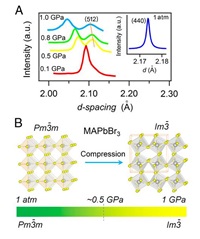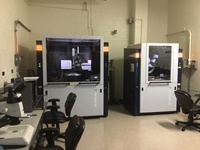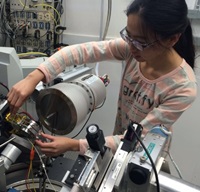News
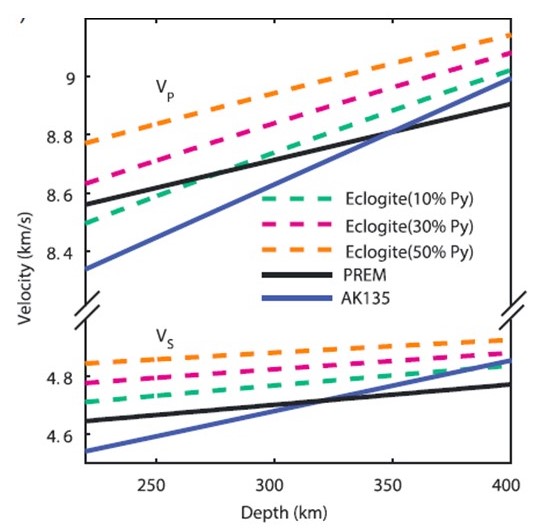
Pyrope is an Mg end-member garnet, which constitutes up to ~15% of the upper mantle.
Thermodynamic and thermoelastic properties of garnet at high pressure and high temperature are
important for understanding the composition and structure of the Earth. Here we report the first-principles
calculations of vibrational properties, thermodynamic properties, and elasticity of pyrope over a wide
pressure and temperature range. The calculated results exhibit good consistency with the available
experimental results and provide values up to the pressure and temperature range that are challenging for
experiments to achieve and measure. Pyrope is almost isotropic at high pressure. The elastic moduli,
especially the shear modulus of pyrope, exhibit nonlinear pressure and temperature dependences. Density
and seismic velocities of pyrope along with piclogite, pyrolite, and eclogite are compared with seismic
models along the normal upper mantle and the cold subducting lithospheric plate geotherms. Pyrope has
the highest density and seismic velocities among the major minerals of the upper mantle along these
geotherms. Eclogite with 30% pyrope and 70% clinopyroxene is denser than the surrounding mantle even
along the normal upper mantle geotherm and becomes still denser along the cold slab geotherm. Seismic
velocities of eclogite with 30% pyrope along the normal upper mantle geotherm are slower than the
surrounding mantle but along the cold slab geotherm are faster than the surrounding mantle.
Read full paper
Back to top
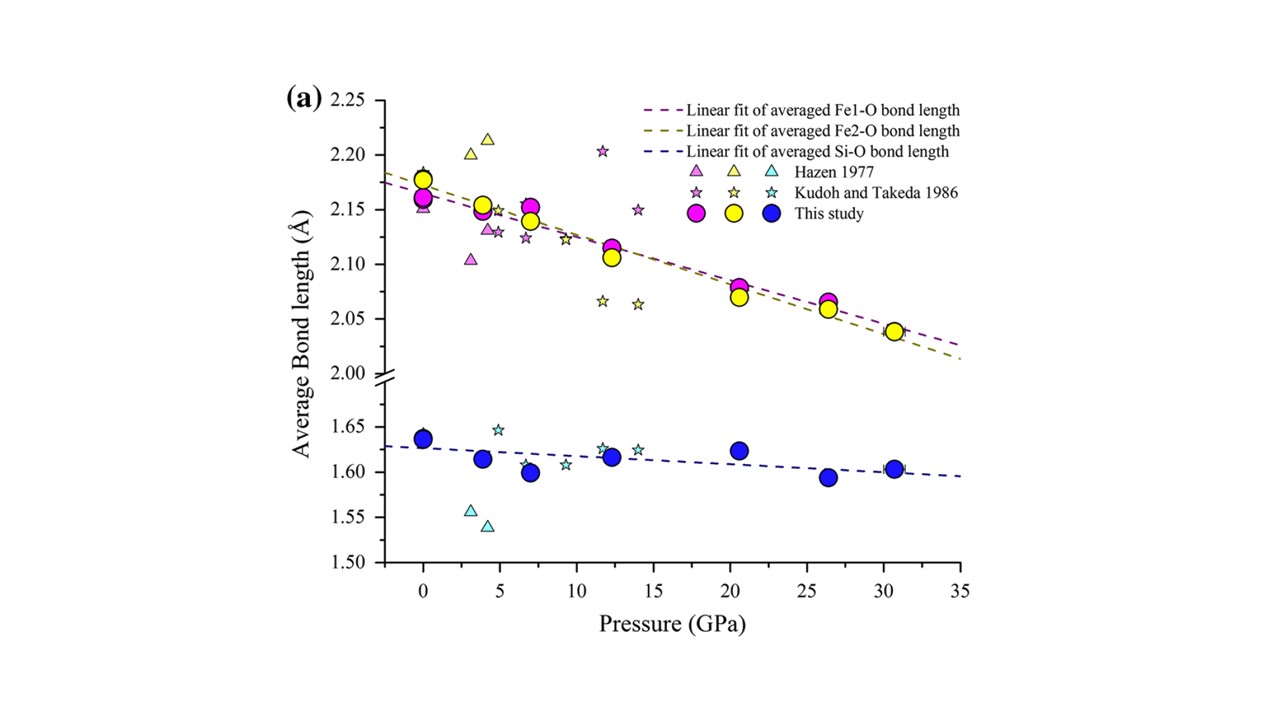
Olivine is widely believed to be the most abundant
mineral in the Earth’s upper mantle. Here, we report
structural refinement results for the Fe-end-member olivine,
Fe2SiO4 fayalite, up to 31 GPa in diamond-anvil cell,
using single-crystal synchrotron X-ray diffraction. Unit-cell
parameters a, b, c and V, average Si–O Fe–O bond lengths,
as well as Si–O Fe–O polyhedral volumes continuously
decrease with increasing pressure. The pressure derivative
of isothermal bulk modulus K′
T0 is determined to be 4.0
(2) using third-order Birch–Murnaghan equation of state
with ambient isothermal bulk modulus fixed to 135 GPa
on the basis of previous Brillouin measurements. The Si–O
tetrahedron is stiffer than the Fe–O octahedra, and the
compression mechanism is dominated by Fe–O bond and
Fe–O octahedral compression. Densities of olivine along
1600 and 900 K adiabats are calculated based on this study.
The existence of metastable olivine inside the cold subduction
slab could cause large positive buoyancy force against
subduction, slow down the subduction and possibly affect
the slab geometry.
Read full paper
Back to top
Organic–inorganic hybrid lead trihalide perovskites have been
emerging as the most attractive photovoltaic materials. As regulated
by Shockley–Queisser theory, a formidable materials science challenge
for improvement to the next level requires further band-gap
narrowing for broader absorption in solar spectrum, while retaining
or even synergistically prolonging the carrier lifetime, a critical factor
responsible for attaining the near-band-gap photovoltage. Herein,
by applying controllable hydrostatic pressure, we have achieved unprecedented
simultaneous enhancement in both band-gap narrowing
and carrier-lifetime prolongation (70% to 100% increase)
under mild pressures at ~0.3 GPa. The pressure-induced modulation
on pure hybrid perovskites without introducing any adverse chemical
or thermal effect clearly demonstrates the importance of band
edges on the photon–electron interaction and maps a pioneering
route toward a further increase in their photovoltaic performance.
Read full paper
Back to top
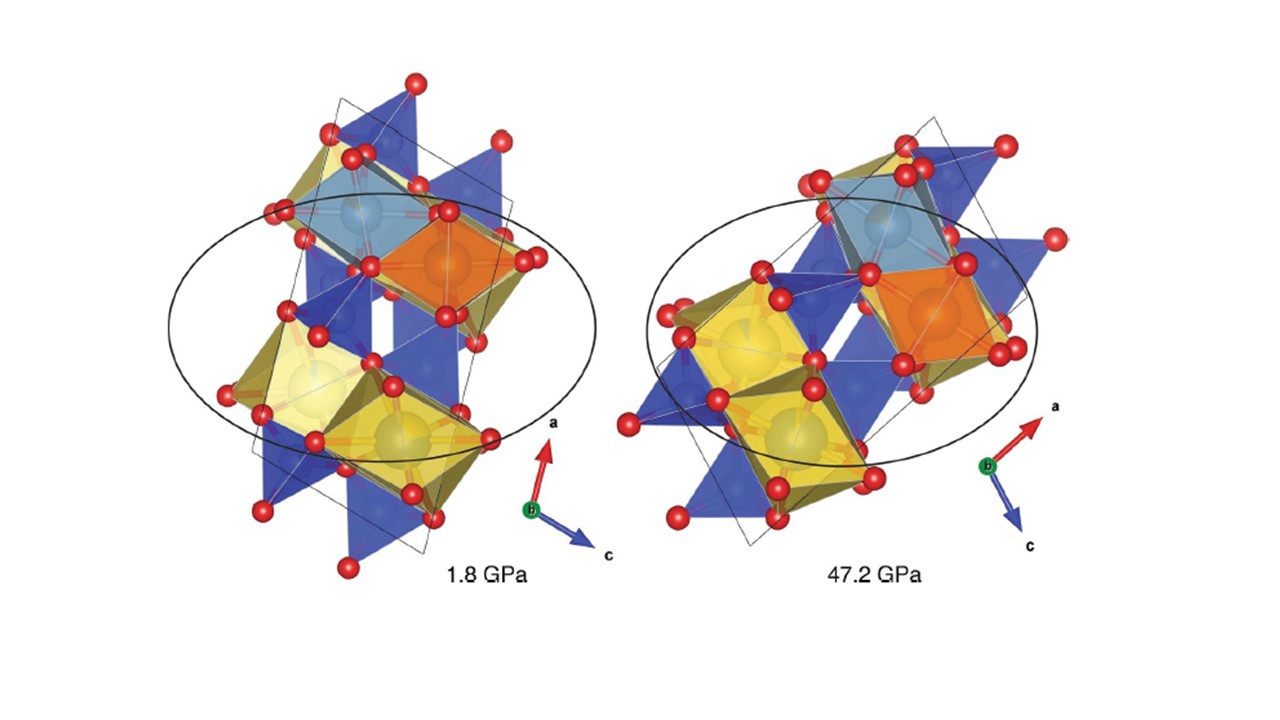
Omphacite is an important mineral component
of eclogite. Single-crystal synchrotron X-ray diffraction
data on natural (Ca, Na) (Mg, Fe, Al)Si2O6 omphacite have
been collected at the Advanced Photon Source beamlines
13-BM-C and 13-ID-D up to 47 GPa at ambient temperature.
Unit cell parameter and crystal structure refinements
were carried out to constrain the isothermal equation of
state and compression mechanism. The third-order Birch–
Murnaghan equation of state (BM3) fit of all data gives
V0 = 423.9(3) Å3, KT0 = 116(2) GPa and KT0′ = 4.3(2).
These elastic parameters are consistent with the general
trend of the diopside–jadeite join. The eight-coordinated
polyhedra (M2 and M21) are the most compressible and
contribute to majority of the unit cell compression, while
the SiO4 tetrahedra (Si1 and Si2) behave as rigid structural
units and are the most incompressible. Axial compressibilities
are determined by fitting linearized BM3 equation
of state to pressure dependences of unit cell parameters.
Throughout the investigated pressure range, the b-axis is
more compressible than the c-axis. The axial compressibility
of the a-axis is the largest among the three axes at
Read full paper
Back to top
X-ray Atlas advanced diffractometer system, funded by the NSF EAR instrumetation grant has been installed in HIG room 154. The system consists of Bruker D8 Venture
single crystal diffractometer and D8 Advance powder diffractometer. Both instruments are equipped with variable temperature devices. D8 Venture features innovative components
such as PHOTON II CPAD detector and Incoatec ImS 3.0 Ag microfocus source with Helios focusing optics, and is being further customized for
high-pressure experiements, including online ruby fluorescence measurments, heavy duty sample platform and membrane-driven pressure control system. Both instruments will
be available for both collaborative as well as service work startin in September 2016.
Read more
Back to top
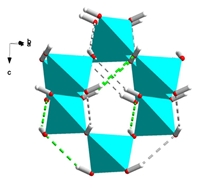
Three isotypic crystals, SiO2 (α-cristobalite), ε-Zn(OH)2 (wülfingite) and Be(OH)2
(β-behoite), with topologically identical frameworks of corner-connected tetrahedra, undergo displacive compression-driven phase transitions
at similar pressures (1.5-2.0 GPa), but each transition is characterized by a different mechanism resulting in different
structural modifications. In this study, we report the crystal structure of the high-pressure γ-phase of beryllium hydroxide and
compare it with the high-pressure structures of the other two minerals. In Be(OH)2, the transition from the ambient
β-behoite phase with the orthorhombic space group P212121 and ambient unit cell parameters
a = 4.5403(4) Å, b = 4.6253(5) Å, c = 7.0599(7) Å, to the high-pressure orthorhombic γ-polymorph with space group Fdd2 and unit cell parameters
(at 5.3(1) GPa) a = 5.738(2) Å, b = 6.260(3) Å, c = 7.200(4) Å takes place between 1.7 and 3.6 GPa. This transition is essentially second order,
is accompanied by a negligible volume discontinuity, and exhibits both displacive and reversible character. The mechanism of the phase
transition results in a change to the hydrogen bond connectivities and rotation of the BeO4 tetrahedra.
Read full paper
Back to top
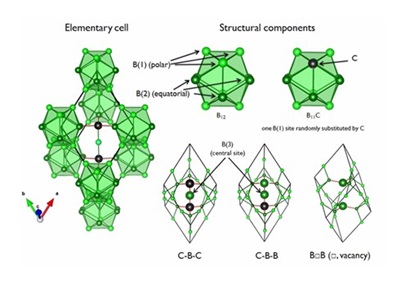
Single-crystal B4.3C boron carbide is investigated through the pressure-dependence and inter-relation of atomic distances,
optical properties and Raman-active phonons up to ~70GPa. The anomalous pressure evolution of the gap width to higher energies is striking.
This is obtained from observations of transparency, which most rapidly increases around 55GPa. Full visible optical transparency is approached
at pressures of>60GPa indicating that the band gap reaches ~3.5eV; at high pressure, boron carbide is a wide-gap semiconductor. The reason is
that the high concentration of structural defects controlling the electronic properties of boron carbide at ambient conditions initially
decreases and finally vanishes at high pressures. The structural parameters and Raman-active phonons indicate a pressure-dependent phase
transition in single-crystal natB4.3C boron carbide near 40GPa, likely related to structural changes in the C–B–C chains, while the basic
icosahedral structure appears to be less affected.
Read full paper
Back to top
The CDAC-supported project at the University of Hawaii started on September 1, 2013. This proposal request renewal
of funding for the fourth year. Currently two Ph.D. students are supported by this project, each at 50%: Yi Hu
(B.Sc. from University of Science and Technology of China, major in geophysics, started the Ph.D. program at UH in August 2013)
and Hanna Shelton (B.Sc. from University of Hawaii, major in chemistry, started the Ph.D. program on September 1, 2014). Since
the beginning of the project our efforts have been focused on training the students in high-pressure techniques, sample preparation,
principles of high-pressure X-ray crystallography and data analysis and crystallographic computations.
Back to top
X-ray Atlas instrument, being developed within the NSF EAR Instrumentation and Facilities project through
acquisition of Bruker D8 Venture/D8 Advance system and further customization, will create a novel state of
the art solution for in situ laboratory-based single-crystal and powder X-ray diffraction experiments at the University of Hawaii.
The new instrument system will be capable of exploring pressure-temperature conditions relevant for the Earth upper mantle,
transition zone and some of the lower mantle. X-ray Atlas will create new and very exciting opportunities for lab-based mineralogy,
petrology and mineral physics undergraduate and graduate research and education, and will serve as personnel training and new technology
prototyping site for HIGP-lead projects at Argonne National Laboratory.
Back to top
On February 1, 2016 Yi Hu successfully passed her PhD Comprehensive Exam. Congratulations Yi!!!
Back to top
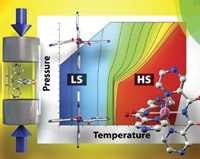
The application of pressure on CoII(dpzca)2, which at ambient pressure undergoes abrupt spin crossover(SCO)
with thermal hysteresis, gives unique insights into SCO. It reversibly separates the crystallographicphase transition
(I41/a↔P21/c) and associated abrupt SCO from the underlying gradual SCO, as shownby detailed room temperature (RT)
X-ray crystallography and temperature dependent magnetic suscepti-bility studies, both under a range of 10 different
pressures. The pressure effects are shown to be reversible.The crystal structure of the pressure-induced low-spin state
is determined at RT at 0.42(2) and 1.78(9)GPa. At the highest pressure of 1.78(9) GPa the Co–N bond lengths are consistent
with the complex beingfully LS, and the conjugated terdentate ligands are significantly distorted out of plane.
The abrupt SCOevent can be shifted up to RT by application of a hydrostatic pressure of 0.4 GPa. These magnetic sus-ceptibility
(vs.temperature) and X-ray crystallography (at RT) studies, under a range of pressures, showthat the SCO can be tuned over a wide
range of temperature and pressure space, including RT SCO.
Read full paper
Back to top
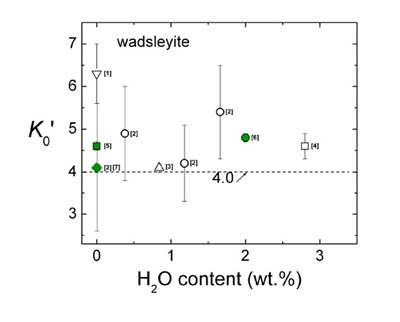
Review of recent mineral physics literature shows consistent trends for the influence of Fe and H2O on the bulk modulus (K0) of
wadsleyite and ringwoodite, the major phases of Earth's mantle transition zone (410–660km). However, there is little consensus on the first
pressure derivative, K0′=(dK/dP)P=0, which ranges from about 4 to >5 across experimental studies and compositions. Here we demonstrate the
importance of K0′ in evaluating the bulk sound velocity of the transition zone in terms of water content and provide new constraints on
the effect of H2O on K0′ for wadsleyite and ringwoodite by conducting a comparative compressibility study. In the experiment, multiple
crystals of hydrous Fo90 wadsleyite containing 2.0 and 0.25 wt% H2O were loaded into the same diamond anvil cell, along with hydrous ringwoodite
containing 1.4 wt% H2O. By measuring their pressure-volume evolution simultaneously up to 32GPa, we constrain the difference in K0′
independent of the pressure scale, finding that H2O has no effect on K0′, whereas the effect of H2O on K0 is significant. The fitted K0′
values of hydrous wadsleyite (0.25 and 2.0 wt% H2O) and hydrous ringwoodite (1.4 wt% H2O) examined in this study were found to be identical
within uncertainty, with K0′ ~3.7(2). New secondary-ion mass spectrometry measurements of the H2O content of these and previously investigated
wadsleyite samples shows the bulk modulus of wadsleyite is reduced by 7.0(5) GPa/wt% H2O, independent of Fe content for upper mantle compositions.
Because K0′ is unaffected by H2O, the reduction of bulk sound velocity in very hydrous regions of transition zone is expected to be on the order
of 1.6%, which is potentially detectible in high-resolution, regional seismology studies.
Read full paper
Back to top
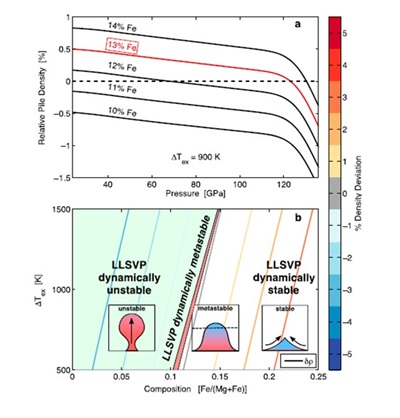
The high-pressure/high-temperature equation of state (EOS) of synthetic 13% Fe-bearing bridgmanite (Mg silicate perovskite)
is measured using powder X-ray diffraction in a laser-heated diamond anvil cell with a quasi-hydrostatic neon pressure medium.
We compare these results, which are consistent with previous 300 K sound speed and compression studies, with a reanalysis of
Fe-free Mg end-member data from Tange et al. (2012) to determine the effect of iron on bridgmanite's thermoelastic properties.
EOS parameters are incorporated into an ideal lattice mixing model to probe the behavior of bridgmanite at deep mantle conditions.
With this model, a nearly pure bridgmanite mantle composition is shown to be inconsistent with density and compressibility profiles
of the lower mantle. We also explore the buoyant stability of bridgmanite over a range of temperatures and compositions expected
for Large Low-Shear Velocity Provinces, concluding that bridgmanite-dominated thermochemical piles are more likely to be passive
dense layers externally supported by convection, rather than internally supported metastable domes. The metastable dome scenario
is estimated to have a relative likelihood of only 4–7%, given the narrow range of compositions and temperatures consistent with
seismic constraints. If buoyantly supported, such structures could not have remained stable with greater thermal contrast early
in Earth's history, ruling out formation scenarios involving a large concentration of heat producing elements.
Read full paper
Back to top


